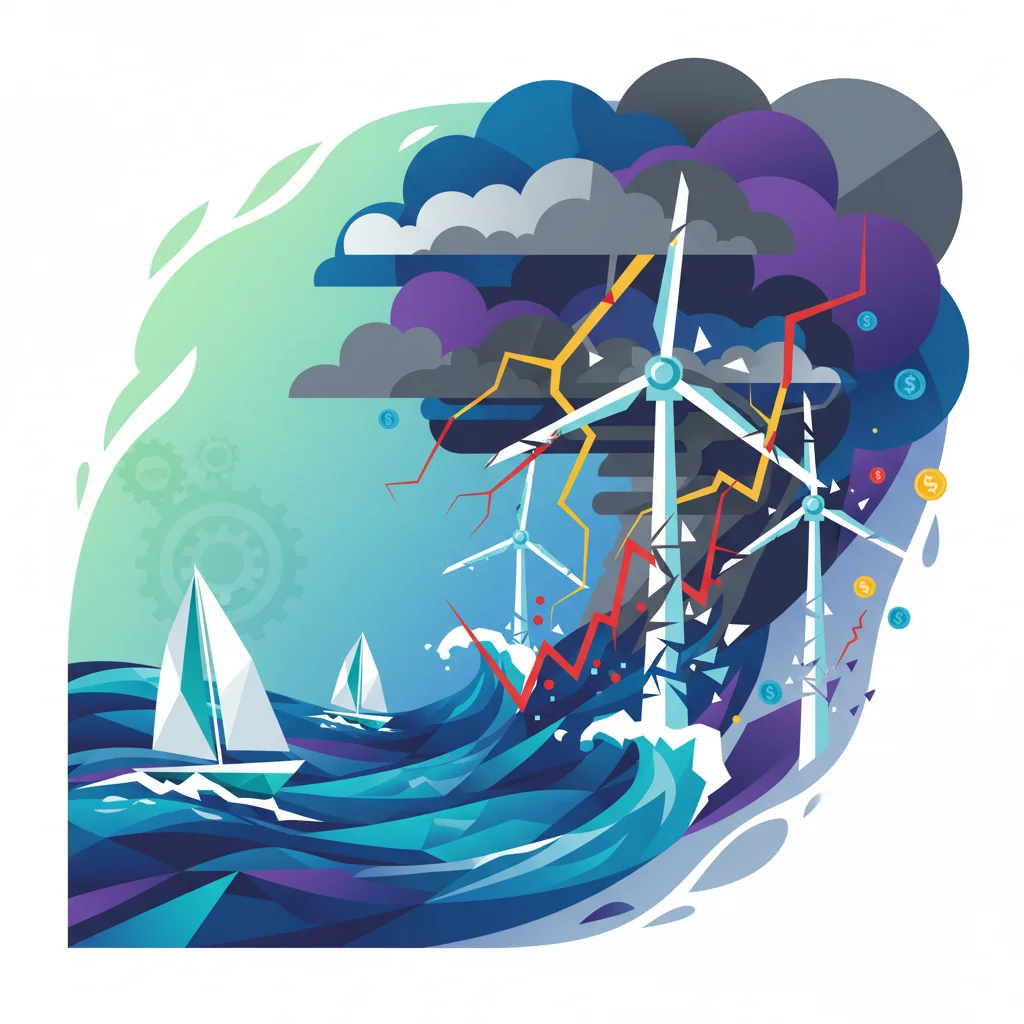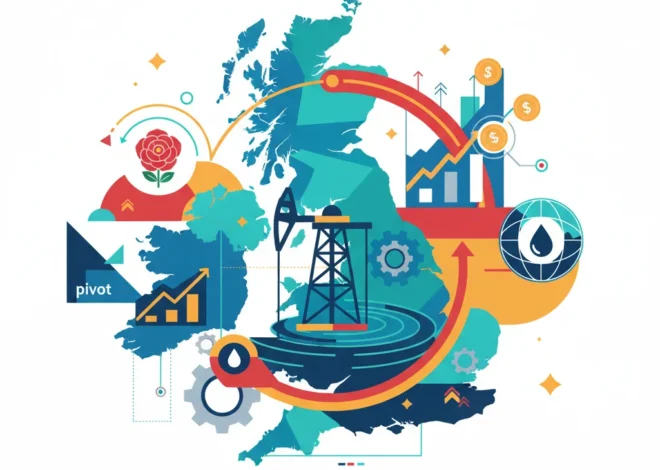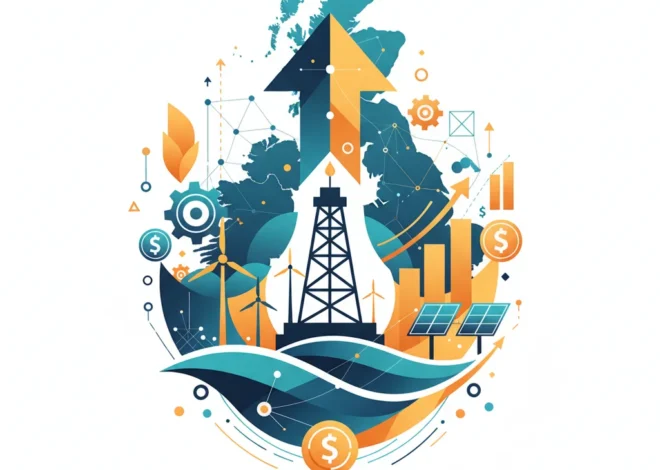
Sailing into the Storm: Why the Offshore Wind Revolution is Facing a Financial Crisis
The Green Dream Meets Economic Reality
Not long ago, offshore wind was hailed as the undisputed champion of the green energy transition. Towering turbines spinning gracefully over the ocean promised a future of abundant, clean power, attracting billions in investment and fueling optimistic projections across the global economy. For investors and policymakers alike, it was a beacon of progress—a perfect marriage of environmental responsibility and long-term financial returns. But today, that beacon is flickering. The industry is sailing directly into a perfect storm, buffeted by fierce economic and political headwinds that threaten to capsize its ambitious boom.
The core of the problem lies in a toxic cocktail of macroeconomic pressures. The era of cheap money, which underwrote the massive upfront capital expenditure required for these giga-projects, is over. Soaring interest rates, persistent supply chain disruptions, and volatile political landscapes have fundamentally altered the economics of offshore wind, turning promising ventures into potential financial black holes. What was once a darling of the ESG investing world is now a cautionary tale of how quickly financial fundamentals can ground even the most celebrated technological advancements.
In this analysis, we’ll dissect the multifaceted crisis facing the offshore wind sector. We will explore how shifts in global finance are crippling project viability, examine the logistical nightmares plaguing the supply chain, and assess the chilling effect of political uncertainty on long-term investment. For business leaders, finance professionals, and anyone with a stake in the energy transition, understanding these dynamics is crucial to navigating the turbulent waters ahead.
The Triad of Trouble: Interest Rates, Supply Chains, and Politics
The challenges confronting the offshore wind industry aren’t isolated incidents; they are interconnected forces creating a powerful vortex of negative pressure. Let’s break down the three primary drivers of this storm.
1. The Crushing Weight of Capital Costs
Offshore wind projects are monuments to modern engineering, but they are also incredibly capital-intensive. Building a large-scale wind farm can cost billions of dollars and take the better part of a decade from planning to power generation. In the zero-interest-rate environment of the 2010s, financing these ventures was relatively straightforward. Developers could secure low-cost, long-term debt, making their financial models work even with tight margins.
Today, that model is broken. Central banks, in their fight against inflation, have dramatically hiked interest rates. For offshore wind developers, this means the cost of borrowing has skyrocketed. A project that was viable with a 2% interest rate becomes a money-losing proposition at 6% or 7%. This has a direct impact on the Levelized Cost of Energy (LCOE)—the price at which electricity must be sold to break even. As financing costs balloon, so does the LCOE, making offshore wind less competitive against other energy sources. According to the Financial Times, the estimated cost of a US offshore wind project has surged by nearly 40% since 2021, a direct consequence of this new financial reality.
The High-Stakes Calculus: Decoding the Economic Ripple Effects of the Gaza Peace Proposal
2. The Global Supply Chain Squeeze
Compounding the financial strain are severe bottlenecks in the global supply chain. The pandemic and subsequent geopolitical tensions have created a ripple effect of delays and price hikes for critical components. The cost of steel for turbine towers, copper for cables, and rare earth minerals for magnets has soared. But the problem runs deeper than just raw materials.
There is a critical shortage of the specialized infrastructure needed to build and install these massive structures. This includes a lack of wind turbine installation vessels (WTIVs)—giant ships capable of lifting and placing nacelles and blades hundreds of feet above the sea. With only a handful of these vessels in operation globally, their day rates have gone through the roof, adding millions to project budgets. This logistical nightmare means projects are not only more expensive but are also facing significant delays, further eroding investor confidence and straining the balance sheets of even the largest players in the industry.
3. The Unpredictable Winds of Politics
Large-scale infrastructure projects require stable, long-term policy support. Unfortunately, the political climate has become another source of turbulence. In the United States, the industry faces vocal opposition, most notably from former President Donald Trump, who has vowed to halt offshore wind development, calling turbines “whale-killing” monstrosities (source). This rhetoric, combined with the potential for a dramatic policy reversal, creates a high-risk environment for investors who need regulatory certainty to commit billions of dollars over a multi-decade horizon.
Beyond national politics, local opposition (“NIMBYism” – Not In My Back Yard) from coastal communities concerned about sightlines, fishing rights, and wildlife impacts adds another layer of permitting complexity and legal challenges. This combination of high-level political risk and grassroots opposition creates a daunting gauntlet for developers to navigate.
To better visualize how these factors compound, consider their direct impact on project development:
| Challenge | Direct Impact on Offshore Wind Projects |
|---|---|
| Higher Interest Rates | Dramatically increases the cost of capital, making projects financially unviable under existing power purchase agreements (PPAs). |
| Supply Chain Inflation | Raises the cost of key components like steel, copper, and turbines, directly inflating the overall project budget. |
| Logistical Bottlenecks | Shortages of specialized vessels and port infrastructure lead to costly construction delays and scheduling conflicts. |
| Political Uncertainty | Creates significant regulatory risk, deterring long-term investment and making it harder to secure financing from the banking sector. |
Beyond the Battlefield: How a US-Backed Economic War on Russian Energy is Shaking Global Markets
Orsted’s Ordeal: A Cautionary Tale for the Stock Market
Perhaps no company exemplifies the industry’s plight better than Denmark’s Orsted, once the global leader and a poster child for the green energy boom. The company’s recent experience serves as a stark case study in how quickly fortunes can turn.
In late 2023, Orsted made the shocking decision to cease development of its Ocean Wind 1 and 2 projects off the coast of New Jersey. The move came with a staggering DKr28.4bn (approximately $4bn) impairment charge, a decision that sent shockwaves through the financial markets (source). The company’s stock plummeted, wiping out billions in market capitalization and triggering a crisis of confidence among investors who had once viewed Orsted as a safe bet on the future of energy.
The reasons for Orsted’s retreat mirror the industry-wide challenges: soaring costs, supply chain delays, and an inability to renegotiate the fixed-price power purchase agreements (PPAs) that were signed in a different economic era. These PPAs, which lock in a price for electricity for 20-30 years, provide revenue certainty but become an economic straitjacket when costs spiral out of control. Orsted’s painful decision highlights a fundamental flaw in the contracting model that has underpinned the industry’s growth.
Charting a New Course: The Path to Recovery
Despite the bleak outlook, the offshore wind industry is not doomed. The long-term driver—the global imperative to decarbonize—remains as strong as ever. However, for the industry to regain its momentum, a significant course correction is required from all stakeholders.
- Rethinking Government Contracts: Policymakers must move away from rigid, fixed-price PPAs. Future contracts need to incorporate inflation indexation and mechanisms for risk-sharing between developers and governments. This ensures that projects remain economically viable even when macroeconomic conditions shift.
- Investing in the Supply Chain: Governments and private investors must accelerate investment in domestic manufacturing, port infrastructure, and specialized vessels. Building a robust, localized supply chain will not only reduce costs and delays but also create jobs and enhance energy security.
- Innovation in Financial Technology: The crisis may spur innovation in project financing. We could see the rise of new fintech platforms designed to pool capital, manage risk more effectively, and bring greater transparency to large-scale infrastructure investing. Sophisticated financial modeling and risk-assessment tools will become more critical than ever for both developers and their backers in the banking and investment communities.
- Policy Stability: Above all, the industry needs clear, consistent, and long-term policy support. The stop-start nature of political commitment is toxic for an industry that operates on multi-decade investment cycles. A stable regulatory environment is the bedrock upon which the entire sector’s recovery must be built.
Investing in the Skies: Why the Boeing-Airbus Duopoly is Facing Its Greatest Challenge
Conclusion: A Storm to Weather, Not a Ship to Abandon
The offshore wind industry is undeniably in the eye of a severe economic and political storm. The euphoric growth of the past decade has given way to a harsh reality check, forcing painful writedowns and project cancellations. The journey ahead will be choppy, and not all players will survive.
However, it’s crucial to distinguish between a cyclical downturn and a structural collapse. The fundamental need for clean energy is not going away. The current crisis is a powerful, market-enforced stress test that will ultimately forge a stronger, more economically disciplined industry. For investors, business leaders, and policymakers, the challenge is not to abandon ship, but to learn how to navigate these stormy seas. The companies and countries that adapt, innovate, and build resilience today will be the ones to harness the powerful winds of tomorrow’s energy economy.


